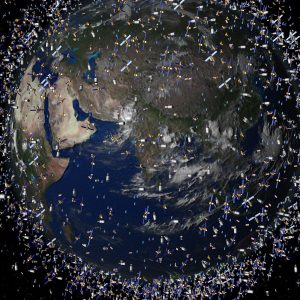Link About It: This Week’s Picks
A Native American woman in space, Nick Cave’s new textiles, tightening rules for orbital debris and more

California Becomes the First Official Sanctuary State for Trans Youth
 Last week, California Governor Gavin Newsom passed SB 107, a law that prohibits other states from prosecuting families seeking gender-affirming care in California. The new legislation (which was introduced by state senator Scott Wiener) makes the state the first official sanctuary for transgender youth, ensuring that no out-of-state subpoenas will interfere with a child’s right to receive gender-related care. Additionally, it protects the safety of trans youth by allowing doctors to disregard requests from other states for gender-related medical information and granting state courts emergency jurisdiction over child custody cases for families fleeing anti-trans investigation. As these sentiments and legislations have been ramping up across the country, SB 107 comes as a vital, life-saving victory. Learn more about it at them.
Last week, California Governor Gavin Newsom passed SB 107, a law that prohibits other states from prosecuting families seeking gender-affirming care in California. The new legislation (which was introduced by state senator Scott Wiener) makes the state the first official sanctuary for transgender youth, ensuring that no out-of-state subpoenas will interfere with a child’s right to receive gender-related care. Additionally, it protects the safety of trans youth by allowing doctors to disregard requests from other states for gender-related medical information and granting state courts emergency jurisdiction over child custody cases for families fleeing anti-trans investigation. As these sentiments and legislations have been ramping up across the country, SB 107 comes as a vital, life-saving victory. Learn more about it at them.
Image courtesy of Humberto Portillo/Unsplash
Artist Nick Cave’s Knoll Textile Collection
 Ahead of Nick Cave’s forthcoming survey exhibition, Forothermore, opening at NYC’s Guggenheim Museum, the celebrated artist, sculptor, dancer and professor announced a collaboration with Knoll: a 10-piece collection of textiles “consisting of four upholsteries, three draperies and three wall-coverings.” The vibrant collection “conveys Cave’s sense of dimension, color and movement, with each design referencing a specific artwork and dutifully capturing the visceral and tactile essence of the original piece.” Cave says, “When I was invited to do this collaboration, I immediately thought of Cranbrook [Academy of Art], where I did my graduate work. I was surrounded by Knoll and by Saarinen. I would pull out these amazing textiles created in the 1970s, and think about the Arts and Crafts movement and its influence. It’s part of my DNA now. I’m always thinking about the transition: how does an artwork transition into a textile or bronze? It comes down to the essence, and transferring that essence over.” Find out more about the dynamic collection at Wallpaper*.
Ahead of Nick Cave’s forthcoming survey exhibition, Forothermore, opening at NYC’s Guggenheim Museum, the celebrated artist, sculptor, dancer and professor announced a collaboration with Knoll: a 10-piece collection of textiles “consisting of four upholsteries, three draperies and three wall-coverings.” The vibrant collection “conveys Cave’s sense of dimension, color and movement, with each design referencing a specific artwork and dutifully capturing the visceral and tactile essence of the original piece.” Cave says, “When I was invited to do this collaboration, I immediately thought of Cranbrook [Academy of Art], where I did my graduate work. I was surrounded by Knoll and by Saarinen. I would pull out these amazing textiles created in the 1970s, and think about the Arts and Crafts movement and its influence. It’s part of my DNA now. I’m always thinking about the transition: how does an artwork transition into a textile or bronze? It comes down to the essence, and transferring that essence over.” Find out more about the dynamic collection at Wallpaper*.
Image courtesy of Lyndon French/Wallpaper*
How Cheese Can Help Fight Climate Change
 In Vermont, small artisanal cheesemakers are working to make cheese regeneratively and renewably in order to help combat climate change. For these turophiles, cheese is more than a delectable provision and could be a solution to the warming climate—one that harkens back 11,000 years. As University of Vermont’s professor of nutrition and food science, Paul Kindstedt explains, that was “the beginning of an extraordinarily moist, warm, stable human-friendly epoch in climate history that unleashed the power of agriculture and the full potential of our species, for better or for worse.” There were some significant climate and weather changes (for example, a temperature drop in 4000 BCE and flooding in Holland during the Medieval Warm Period) when dairying was heavily relied upon. Kindstedt continues, “Dairying and cheesemaking have repeatedly served as an irreplaceable fallback option for humanity to cope with climatic catastrophes.” This is partly because making cheese requires grass that grows easily while capturing carbon. At Shelburne Farms, for instance, the soil hasn’t been tilled since 1993, resulting in high levels of carbon in their land—which means it’s “stored” there, rather than being released as carbon dioxide. Learn more at Food52.
In Vermont, small artisanal cheesemakers are working to make cheese regeneratively and renewably in order to help combat climate change. For these turophiles, cheese is more than a delectable provision and could be a solution to the warming climate—one that harkens back 11,000 years. As University of Vermont’s professor of nutrition and food science, Paul Kindstedt explains, that was “the beginning of an extraordinarily moist, warm, stable human-friendly epoch in climate history that unleashed the power of agriculture and the full potential of our species, for better or for worse.” There were some significant climate and weather changes (for example, a temperature drop in 4000 BCE and flooding in Holland during the Medieval Warm Period) when dairying was heavily relied upon. Kindstedt continues, “Dairying and cheesemaking have repeatedly served as an irreplaceable fallback option for humanity to cope with climatic catastrophes.” This is partly because making cheese requires grass that grows easily while capturing carbon. At Shelburne Farms, for instance, the soil hasn’t been tilled since 1993, resulting in high levels of carbon in their land—which means it’s “stored” there, rather than being released as carbon dioxide. Learn more at Food52.
Image courtesy of Shana Novak/Getty Images
NASA and SpinLaunch Test Catapulting Objects Into Space
 SpinLaunch is a US startup that focuses on mass accelerator technology that facilitates non-rocket space launches, and recently NASA tested their system—essentially catapulting objects into orbit. In New Mexico’s Spaceport America on 27 September, SpinLaunch’s 10th successful test occurred, sending NASA payload of “a gyroscope, a magnetometer, two accelerometers and sensors for temperature and humidity” safely into orbit. It proves that mass accelerators could be a viable alternative to costly, fuel-guzzling rockets. Read more at Interesting Engineering.
SpinLaunch is a US startup that focuses on mass accelerator technology that facilitates non-rocket space launches, and recently NASA tested their system—essentially catapulting objects into orbit. In New Mexico’s Spaceport America on 27 September, SpinLaunch’s 10th successful test occurred, sending NASA payload of “a gyroscope, a magnetometer, two accelerometers and sensors for temperature and humidity” safely into orbit. It proves that mass accelerators could be a viable alternative to costly, fuel-guzzling rockets. Read more at Interesting Engineering.
Image courtesy of SpinLaunch
Wax Worms Could Revolutionize Recycling Plastic
 Scientists have found that wax worms (which are the caterpillar larvae of wax moths) have saliva with two enzymes that break down durable polyethylene—a widely produced plastic. The discovery was made when “one scientist, an amateur beekeeper, cleaned out an infested hive and found the larvae started eating holes in a plastic refuse bag.” As Dr Federica Bertocchini of the Biological Research Centre in Madrid says, “After a while, I noticed lots of holes and we found it wasn’t only chewing, it was [chemical breakdown].” The enzymes are so powerful that just an hour’s exposure is akin to years of natural wear. While there’s more research to be done, this humble worm could help revolutionize plastic recycling. Read more at The Guardian.
Scientists have found that wax worms (which are the caterpillar larvae of wax moths) have saliva with two enzymes that break down durable polyethylene—a widely produced plastic. The discovery was made when “one scientist, an amateur beekeeper, cleaned out an infested hive and found the larvae started eating holes in a plastic refuse bag.” As Dr Federica Bertocchini of the Biological Research Centre in Madrid says, “After a while, I noticed lots of holes and we found it wasn’t only chewing, it was [chemical breakdown].” The enzymes are so powerful that just an hour’s exposure is akin to years of natural wear. While there’s more research to be done, this humble worm could help revolutionize plastic recycling. Read more at The Guardian.
Image courtesy of CSIC Communications Department/PA
The First Native American Woman in Space, Nicole Mann
 On 5 October, Nicole Mann became the first Native American woman in space. As a Marine Corps pilot, astronaut and member of the Wailacki tribe of the Round Valley Indian Tribes, Mann was aboard the SpaceX Dragon spacecraft as a part of the Crew-5 mission, a six-month endeavor at the International Space Station to conduct 200+ experiments and spacewalks. Mann, who commanded the spacecraft, represents a major milestone for Native communities and US history. She says, “These young women, maybe Natives, maybe people from different backgrounds, that realize that they have these opportunities and potentially these barriers that used to be there are starting to be broken down. And so hopefully that will inspire that younger generation.” Read more about the historic moment at NPR.
On 5 October, Nicole Mann became the first Native American woman in space. As a Marine Corps pilot, astronaut and member of the Wailacki tribe of the Round Valley Indian Tribes, Mann was aboard the SpaceX Dragon spacecraft as a part of the Crew-5 mission, a six-month endeavor at the International Space Station to conduct 200+ experiments and spacewalks. Mann, who commanded the spacecraft, represents a major milestone for Native communities and US history. She says, “These young women, maybe Natives, maybe people from different backgrounds, that realize that they have these opportunities and potentially these barriers that used to be there are starting to be broken down. And so hopefully that will inspire that younger generation.” Read more about the historic moment at NPR.
Image courtesy of Nicole Mann
FCC Tightens Rules Governing Space Junk
 Last week, the US Federal Communications Commission reduced the term that space agencies and private companies can leave orbital debris in place from 25 years to five. Though the rule was declared without support from NASA or Congress, it will be in effect for “anyone who wants to launch a satellite that needs a license from the agency to use a slice of the electromagnetic spectrum for communication,” according to Wired. Orbital pollution can be addressed in two ways: moving it into a lower orbit so that it can fall into (and burn up within) Earth’s atmosphere or by developing cleanup technologies specifically for space trash. The FCC has been met with resistance, and space agencies strongly support the 25-year rule. Read about the increasing dangers of space junk and more at Wired.
Last week, the US Federal Communications Commission reduced the term that space agencies and private companies can leave orbital debris in place from 25 years to five. Though the rule was declared without support from NASA or Congress, it will be in effect for “anyone who wants to launch a satellite that needs a license from the agency to use a slice of the electromagnetic spectrum for communication,” according to Wired. Orbital pollution can be addressed in two ways: moving it into a lower orbit so that it can fall into (and burn up within) Earth’s atmosphere or by developing cleanup technologies specifically for space trash. The FCC has been met with resistance, and space agencies strongly support the 25-year rule. Read about the increasing dangers of space junk and more at Wired.
Artistic rendering courtesy of National Geographic
Link About It is our filtered look at the web, shared daily in Link and on social media, and rounded up every Saturday morning. Hero image courtesy of Lyndon French/Wallpaper*












